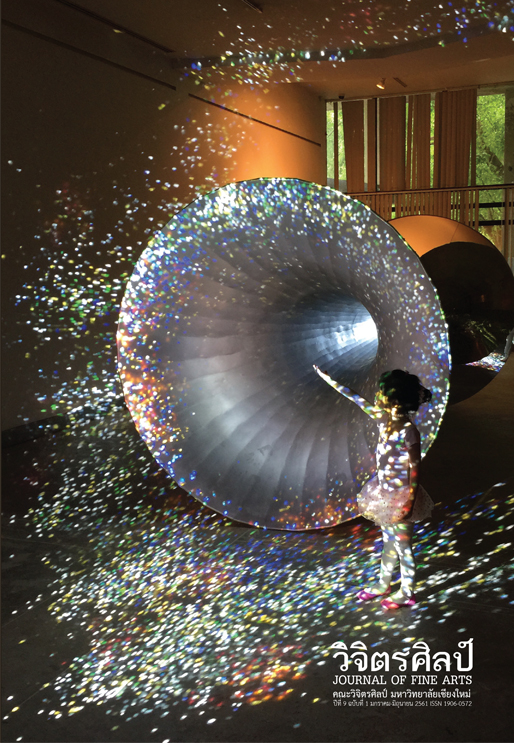ศึกษาและพัฒนาสินค้าตกแต่งห้องทำงานจากอัตลักษณ์ไทยให้หน่วยงานภาครัฐด้วยเทคนิคยาถมดำไร้สารพิษ
Main Article Content
Abstract
Research and development decor items from Thai identify for government office with technology Lead free Nielloware
The aim of this research was to identify methods for the government office to support lead-free Nielloware concepts in the development of products. The research studied the Thai context of tourism around Rattanakosin Island and presented the concept of souvenirs design for decorative office government agencies which integrate with the technology of lead free Nielloware concept patented by Srinakharinwirot University. The research method started with the Thai architectural context, and the educational process of observers traveling with the visual artists. Sketch images as well as photographs were produced to appreciate the value and importance of stories around Rattanakosin Island. These were then selected and integrated into the product design of lead free Nielloware. Research and interviews with experts were analyzed to create design specifications. They were then synthesized into the design logo and souvenirs of tourist attraction around Rattanakosin Island.
Nielloware patterns and products incorporated the multicultural identity and history of the early Rattanakosin period, where art forms were obtained through trade with China The patents of Srinakharinwirot University are:
1. Pen holder based on concept of Rattanakosin Island 2. Lamps based on the concept of the temple of the Emerald Buddha (Wat Phra Kaew), that has inherited the a prototype of Wat Phra Sri Sanphet, Ayutthaya. The pattern consists of patterned ceramic inspired by Temple of the Dawn (Wat Arun) 3. Picture Frames and the business card holder based on the Reclining Buddha (Wat Pho) 4. A note box, paperweight and pencil holders based on the concept of the Mount Pagoda model, Wat Saket (The Golden Mount). Finally, there are pencil holders with concepts of the Democracy Monument, which was influenced by Western design and is the people's symbol. The final development is a set of desk products for government agencies and a souvenir to promote the image of Thailand.
Article Details
References
ใน กรุงเทพธุรกิจ, 2559. สืบค้นเมื่อวันที่ 10 มกราคม 2560. https://
www.bangkokbiznews.com/blog/detail/639453.
2. ขจีพร วงศ์ปรีดี. “มศว ผลิตแท่งยาถมปราศจากตะกั่ว หวั่นช่างฝีมือเครื่องถม
ลงยา เมืองนครฯ รับสารตะกั่ว มีปัญหาด้านสุขภาพ.” SWU Weekly
ประจำวันที่ 11 กันยายน, 2555.
3. พจน์ ใจชาญสุขกิจ. “ยุทธศาตร์การใช้การสื่อสารเชิงบูรณาการเพื่อสร้าง
Brand Image ของธนาคารพานิชย์ไทย ภายหลังวิกฤตการณ์ทาง
เศรษฐกิจในการแข่งขันธุรกิจการค้าปลีก.” ดุษฎีนิพนธ์การจัดการ
ดุษฎีบัณฑิต, สาขาวิชาการจัดการการสื่อสาร มหาวิทยาลัยราชภัฎ
สวนดุสิต, 2549.
4. สุวิทย์ เมษินทรีย์. “ข้อมูลประเทศไทย 4.0.” สืบค้นเมื่อวันที่ 10 มกราคม
2560. https://www.thairath.co.th/content/613903.
5. ผู้จัดการออนไลน์. ““อนุสาวรีย์ประชาธิปไตย” สัญลักษณ์แห่งการ
เปลี่ยนแปลงการปกครอง, 2558.” สืบค้นเมื่อวันที่10 มกราคม
2560. https://www.manager.co.th/ Travel/ ViewNews.aspx?
NewsID=9580000135732.
6. วัชรวีร์ ศรีสรรพางค์ และคณะ. งานช่างศิลป์ไทย: ปูนปั้น เครื่องถมและลงยา
เครื่องรัก ประดับมุก ประดับกระจก. กรุงเทพฯ: คติ, 2555.
7. Kostya Kolesov. “ข้อมูลผลิตภัณฑ์ที่ระลึกแบรนด์ Jsouv.” สืบค้นเมื่อวันที่
10 มกราคม 2560. https://www.home-designing.com/2016/04/
jsouv-a-beautifully-minimalist-souvenir-set-depictingarchitectural-landmarks.

